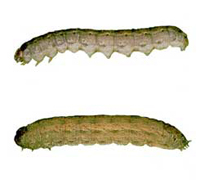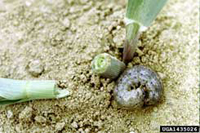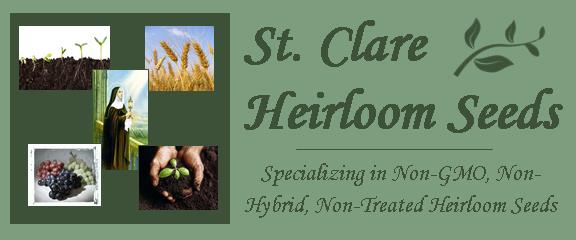
Cutworms in the Heirloom / Open Pollinated Vegetable Garden

Cutworms are the larvae, or young, of stout, dull-colored moths (millers) that fly at night. The different species attack Heirloom / Open Pollinated vegetable plants in different ways. The most conspicuous( and frustrating!) damage is done by the cutworms that cut down young plants by feeding on the stems. If you see cutworms in your Heirloom / Open Pollinated vegetable garden, or plant damage that is evidence of their presence, act promptly to control them. A heavy infestation can ruin a Heirloom / Open Pollinated vegetable garden in short order.
In appearance and feeding habits cutworms vary according to species. There are many species, and cutworm’s live in all parts of the world. Those of the more common species are stout, soft-bodied, smooth, and cylindrical. They may be brown, gray, or nearly black. Some are spotted, others striped.

Most cutworms hide in the soil during the day and feed in the evening and at night. On dark, cloudy days you may sometimes see them above ground earlier in the day. Usually, however, if you are to see them in the daytime, you must search for them in the soil near the plants on which they feed at night. In the soil they are generally in a coiled position.
Cutworms feed on most kinds of plants, but cause greatest damage to Heirloom / Open Pollinated vegetable garden crops. The plants we have most had them attack in our gardens have been tomato, pepper, cabbage, and occasionally corn. They start feeding in the spring; therefore vegetable gardeners should keep a close watch on young Heirloom / Open Pollinated transplants. Some species cut off the vegetable plants just above the soil surface, others at the surface, and still others just below the surface. Some climb the stems to feed on buds, leaves, or fruit, and some remain in the soil to feed on roots and underground portions of the vegetable garden plants.
Whatever the method of feeding, the result is the same: plant damage to a degree that places cutworms among the foremost insect pests of the Heirloom / Open Pollinated vegetable garden. Cutworms destructive only in the immature stage, not the moth/adult stage. The adults (moths) have mouth parts for sucking, not for chewing. The moths feed on nectar and do not injure plants.
The eggs of most species of moths that produce cutworms are laid on the stems of grass and weeds, or behind the leaf sheath of these plants. The eggs of some species are laid on bare ground. Each female moth may lay from a few hundred to as many as 1,500 eggs. The egg stage lasts from 2 days to 2 weeks. From the eggs emerge the larvae (cutworms).
Most cutworms pass the winter in the larval stage, hidden in the soil, or under trash, or in clumps of grass. They resume feeding in the spring and grow until early summer, when the full-grown larvae enter the next stage of development: In hollowed-out cells, or chambers, they change to pupae. Next, the pupae change to moths. Both these changes take place beneath the surface of the soil. The moths emerge from the soil, and the females soon lay eggs; another generation of cutworm’s is thus started.
Some species of cutworms pupate in the fall and pass the winter as pupae in the soil. The adults emerge early in the spring. In most of the common species there is but one generation a year. In a few species there are two, three, or four generations a year, and sometimes there is so much overlapping of generations that moths may be found at almost any time from late spring to the middle of the fall. The cutworm’s in the northern part of the United States usually have just one generation a year.
Management
Regularly check your garden, especially during late afternoon and evening when cutworms begin to be active, so you can detect their activity when they are first present, and hopefully before they have a chance to do damage. Also inspect your plants in the morning when damage is fresh and easier to see. Watch for plants cut off near the ground or plants that are noticeably wilting (when cutworms chew on the stems but do not sever the plant). Be aware that wilting can also be a sign of needing water. So, check for cutworms, also, but notice if your garden needs watering. You may also detect droppings on the ground, which can indicate cutworm feeding. To verify cutworms are present, run your hand over the soil, rolling over soil clumps and other potential hiding places within a one foot square area of the damage.
Control of cutworms is more effective when the larvae are small. For some crops, such as tomatoes, peppers and celery, you may need to monitor for cutworms until harvest.
For proactively preventing Cutworm damage, you can put cardboard, aluminum foil, or PVC pipe rings/collars around each vegetable garden plant that will prevent the Cutworm from eating it. You can do this at the time of planting seedlings out in the garden, or if you discover a problem with cutworms, you can put the rings or collars you around your young plants that have not been attacked yet to protect them. Whatever form of rings or collars you choose to use make sure to settle them into the soil a bit so they keep cutworms that tend to eat below the soil surface from getting to the stem of your plants, too.
Another thing you can try is when you find a plant that a Cutworm has eaten, dig gently around the base of the vegetable plant to find the Cutworm and then get rid of it. After a Cutworm eats a vegetable plant they usually curl up and go to sleep at the base of the vegetable plant, either on the surface or just under it.A good time to check your
Our favorite collars/rings are PVC rings to place around plant bases, sunken a little into the soil. These rings are reusable year after year. To make these just buy a length of 3 in. diameter PVC pipe and cut every 2 inches making 2 inch high rings, and place around the base of all plants that would typically be attacked by cutworms.

